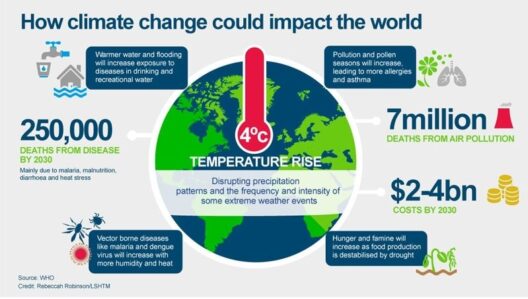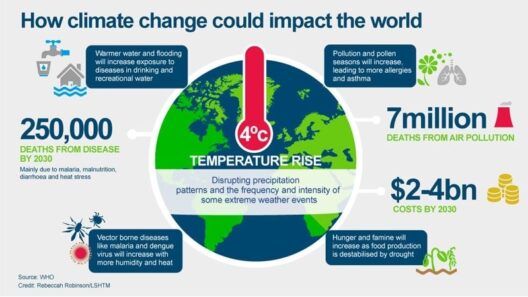In the grand symphony of Earth’s climate, every note matters. Global warming, a resounding crescendo in this orchestration, emerges as a direct consequence of human activities. It’s an intricate story of cause and effect, woven through the lens of science, where atmospheric chemistry plays a pivotal role. At the heart of this phenomenon lies the greenhouse effect, a natural process akin to wrapping our planet in a warm, protective blanket. However, the increasing concentration of greenhouse gases (GHGs) serves to thicken this blanket, trapping more heat than ever before.
To understand the science behind a warming world, one must first unravel the fabric of GHGs. Carbon dioxide (CO2), methane (CH4), and nitrous oxide (N2O) are the most prevalent culprits. These gases, released through fossil fuel combustion, agriculture, and deforestation, have escalated dramatically since the Industrial Revolution. CO2, in particular, stands as a titan among GHGs, with its atmospheric levels surpassing 400 parts per million—unprecedented in at least 800,000 years.
As we delve deeper, we encounter the complex interactions between the atmosphere, oceans, and land surfaces. The oceans, acting as an enormous heat sink, absorb nearly one-third of the CO2 emissions. This interaction is akin to a sponge soaking up water, yet it comes at a costly price. Ocean acidification emerges as a severe consequence, threatening marine biodiversity and disrupting ecosystems. Coral reefs, often dubbed the rainforests of the sea, are particularly vulnerable, experiencing significant bleaching events that compromise their survival.
Another dimension of this warming narrative involves the concept of feedback loops. These are processes wherein the outcome of an event amplifies or dampens the initial stimulus. One striking example can be found in the melting of polar ice caps. As ice melts, darker ocean waters are exposed, allowing for increased heat absorption—a phenomenon known as albedo change. This, in turn, accelerates further ice melt and the cycle perpetuates. It is a veritable feedback loop, a relentless spiral that augments the warming trend.
Consider the phenomenon of permafrost thawing in Arctic regions. Permafrost, a frozen layer of soil rich in organic matter, has sequestered carbon for millennia. When this frozen fortress begins to thaw, it releases significant amounts of CO2 and methane, further exacerbating global warming. This scenario, a perfect illustration of nature’s intricate balancing act, emphasizes how interconnected our climate systems truly are.
The impacts of these scientific processes manifest starkly in our daily lives. Weather patterns grow increasingly erratic, presenting challenges that resonate across all hemispheres. Heatwaves, characterized by extreme temperature anomalies, become more frequent, exacerbating droughts and straining water resources. Increased precipitation leads to flooding, while hurricane intensity escalates, fueled by warmer ocean waters. Each weather aberration narrates its own tale, one of human adjustment and resilience—or vulnerability.
As the barometer of weather shifts, so too does the realm of agriculture. Crops reliant on specific temperature and precipitation patterns face unprecedented challenges. Regions once fertile may become arid, while others that were inhospitable could become new havens. Farmers, as the vanguards of food production, find themselves in a battle to conserve traditional agricultural practices while adapting to the evolving climatic demands.
Moreover, the implications of global warming extend beyond immediate environmental concerns. The interplay of climate change with socio-economic factors exacerbates existing inequalities. Vulnerable communities, often bearing the brunt of climate impacts, may find themselves displaced, leading to heightened migration pressures. This scenario underscores a poignant reality: climate change is not merely an environmental issue; it is a multifaceted socio-political quagmire.
Yet, within this tapestry of challenges lies an opportunity for innovation and resilience. The scientific community is at the forefront, unraveling the mysteries of climate dynamics while seeking sustainable solutions. Renewable energy technologies such as solar, wind, and hydropower emerge as beacons of hope. The transition from fossil fuels to clean energy not only mitigates GHG emissions but also promises a decoupling from the constraints of the past.
In tandem, carbon capture and storage (CCS) technologies promise to ameliorate some of the atmospheric burdens we have collectively wrought. These technologies seek to identify and sequester CO2 emissions before they escape into the atmosphere, acting as a safeguard against further warming. Innovations in sustainable agriculture and reforestation initiatives further galvanize our efforts toward a more carbon-neutral future.
Community engagement plays an integral role in combating global warming. Grassroots movements and educational initiatives empower individuals to make environmentally conscious choices. From reducing plastic consumption to advocating for policies aimed at climate resilience, community action is a powerful instrument for change.
Ultimately, understanding the science of a warming world necessitates a shift in our collective consciousness. The narrative of climate change, intertwined with human history, serves as both a cautionary tale and a clarion call to action. As stewards of this planet, we hold the keys to the future—orchestrating a harmonious coexistence with our environment. Embracing science and advocating for sustainable practices is paramount in ensuring that the symphony of our planet continues to resonate for generations to come. Our choices today will dictate the melody of tomorrow, and it is imperative that we strive for a composition rich in resilience, equity, and harmony.







